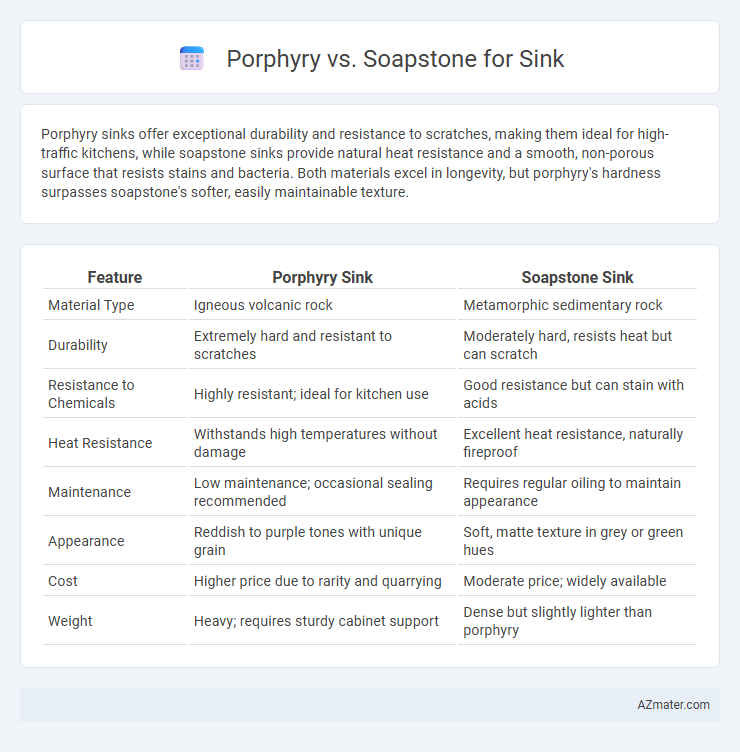Porphyry sinks offer exceptional durability and resistance to scratches, making them ideal for high-traffic kitchens, while soapstone sinks provide natural heat resistance and a smooth, non-porous surface that resists stains and bacteria. Both materials excel in longevity, but porphyry's hardness surpasses soapstone's softer, easily maintainable texture.
Table of Comparison
| Feature | Porphyry Sink | Soapstone Sink |
|---|---|---|
| Material Type | Igneous volcanic rock | Metamorphic sedimentary rock |
| Durability | Extremely hard and resistant to scratches | Moderately hard, resists heat but can scratch |
| Resistance to Chemicals | Highly resistant; ideal for kitchen use | Good resistance but can stain with acids |
| Heat Resistance | Withstands high temperatures without damage | Excellent heat resistance, naturally fireproof |
| Maintenance | Low maintenance; occasional sealing recommended | Requires regular oiling to maintain appearance |
| Appearance | Reddish to purple tones with unique grain | Soft, matte texture in grey or green hues |
| Cost | Higher price due to rarity and quarrying | Moderate price; widely available |
| Weight | Heavy; requires sturdy cabinet support | Dense but slightly lighter than porphyry |
Introduction to Porphyry and Soapstone Sinks
Porphyry sinks are crafted from a durable, coarse-grained igneous rock known for its distinctive reddish or purple hues and natural veining, providing a luxurious and resilient option for kitchen or bathroom use. Soapstone sinks, made from a soft, metamorphic rock primarily composed of talc, offer exceptional heat resistance and a smooth, matte finish that develops a unique patina over time. Both materials provide durability and aesthetic appeal, but Porphyry emphasizes hardness and rich coloration, while Soapstone highlights thermal properties and a timeless, natural look.
Material Composition and Properties
Porphyry sinks are crafted from igneous rock characterized by large, well-formed crystals embedded in a fine-grained matrix, providing exceptional hardness and durability. Soapstone sinks, composed mainly of talc and magnesium silicate, offer a softer, smooth surface with excellent heat resistance and natural chemical inertness. The dense, non-porous nature of porphyry ensures high scratch resistance, while soapstone's ability to resist stains and its pleasant, warm touch make it ideal for kitchen and bathroom sinks.
Aesthetic Differences: Color and Texture
Porphyry sinks exhibit a rich, deep color palette ranging from reddish-brown to purple with a distinctive coarse-grained texture featuring embedded crystals, creating a visually striking and luxurious appearance. Soapstone sinks offer a softer, matte finish with smooth, subtle veining in shades of gray, green, or black, providing a more understated and natural look. The choice between porphyry and soapstone depends on whether a bold, textured aesthetic or a smooth, muted surface is preferred for the sink's overall design.
Durability and Longevity Comparison
Porphyry sinks exhibit exceptional durability due to their dense, igneous rock composition, making them highly resistant to scratches, heat, and chemical damage. Soapstone sinks, while softer and more prone to scratches, offer remarkable resistance to stains and heat, developing a unique patina over time that enhances their aesthetic appeal. Porphyry typically provides longer-lasting performance in high-impact environments, whereas soapstone requires more maintenance but can maintain its functional and visual qualities for decades with proper care.
Resistance to Stains and Scratches
Porphyry exhibits exceptional resistance to stains and scratches due to its dense, hard composition and low porosity, making it highly durable for sink surfaces. Soapstone, while softer and more prone to scratches, is naturally non-porous and highly resistant to staining, with scratches often blending into its patina over time. Choosing between porphyry and soapstone for sinks depends on prioritizing scratch resistance or stain resistance and the desired maintenance level.
Maintenance and Cleaning Requirements
Porphyry sinks require minimal maintenance due to their dense, non-porous surface that resists stains and scratches, while soapstone sinks need regular sealing to prevent discoloration and maintain their smooth texture. Cleaning porphyry is straightforward, typically involving mild soap and water, whereas soapstone benefits from occasional mineral oil applications to enhance its natural patina and protect against wear. Both materials offer durability, but porphyry's low-maintenance properties make it preferable for users seeking easy upkeep.
Installation Considerations
Porphyry sinks require professional installation due to their extreme hardness and weight, demanding specialized tools and precise handling to prevent chipping or cracking. Soapstone sinks, being softer and lighter, are easier to cut and shape onsite, allowing for more straightforward DIY installation and adjustments. Both materials need appropriate sealants to protect against staining, but soapstone's porosity necessitates more frequent maintenance post-installation.
Cost Analysis: Porphyry vs Soapstone
Porphyry sinks generally have a higher initial cost due to the stone's rarity and intricate quarrying process, averaging between $1,200 to $2,500 per unit. Soapstone sinks are more budget-friendly, typically priced from $500 to $1,200, reflecting the stone's abundance and easier workability. When factoring in maintenance, soapstone requires periodic oiling that adds to long-term costs, whereas porphyry's durability and resistance to stains minimize upkeep expenses over time.
Environmental Impact and Sustainability
Porphyry sinks offer long-lasting durability, reducing the need for frequent replacement and minimizing resource consumption over time. Soapstone sinks are naturally non-porous and resistant to chemicals, requiring minimal maintenance and no harmful sealants, which enhances their eco-friendliness. Both materials have relatively low environmental footprints when sourced responsibly, but soapstone's renewable quarrying practices and biodegradability give it a slight sustainability advantage.
Best Applications: Choosing the Right Stone Sink
Porphyry sinks excel in high-traffic commercial kitchens and outdoor settings due to their exceptional hardness and resistance to heat and scratches. Soapstone sinks, prized for their natural resistance to stains and chemical damage, are ideal for residential kitchens where a smooth, warm surface enhances food preparation and easy maintenance. Selecting the right stone sink depends on balancing durability requirements with aesthetic preferences, making porphyry optimal for robust use and soapstone perfect for elegant, everyday functionality.

Infographic: Porphyry vs Soapstone for Sink
 azmater.com
azmater.com